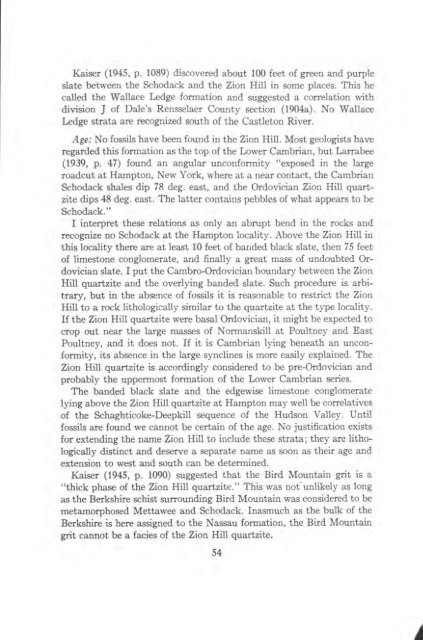STRATIGRAPHY AND STRUCTURE CASTLETON AREA VERMONT
STRATIGRAPHY AND STRUCTURE CASTLETON AREA VERMONT
STRATIGRAPHY AND STRUCTURE CASTLETON AREA VERMONT
You also want an ePaper? Increase the reach of your titles
YUMPU automatically turns print PDFs into web optimized ePapers that Google loves.
Kaiser (1945, P. 1089) discovered about 100 feet of green and purple<br />
slate between the Schodack and the Zion Hill in some places. This he<br />
called the Wallace Ledge formation and suggested a correlation with<br />
division J of Dale's Rensselaer County section (1904a). No Wallace<br />
Ledge strata are recognized south of the Castleton River.<br />
Age: No fossils have been found in the Zion Hill. Most geologists have<br />
regarded this formation as the top of the Lower Cambrian, but Larrabee<br />
(1939, p. 47) found an angular unconformity "exposed in the large<br />
roadcut at Hampton, New York, where at a near contact, the Cambrian<br />
Schodack shales dip 78 deg. east, and the Ordovician Zion Hill quartzite<br />
dips 48 deg. east. The latter contains pebbles of what appears to be<br />
Schodack."<br />
I interpret these relations as only an abrupt bend in the rocks and<br />
recognize no Schodack at the Hampton locality. Above the Zion Hill in<br />
this locality there are at least 10 feet of banded black slate, then 75 feet<br />
of limestone conglomerate, and finally a great mass of undoubted Ordovician<br />
slate. I put the Cambro-Ordovician boundary between the Zion<br />
Hill quartzite and the overlying banded slate. Such procedure is arbitrary,<br />
but in the absence of fossils it is reasonable to restrict the Zion<br />
Hill to a rock lithologically similar to the quartzite at the type locality.<br />
If the Zion Hill quartzite were basal Ordovician, it might be expected to<br />
crop out near the large masses of Normanskill at Poultney and East<br />
Poultney, and it does not. If it is Cambrian lying beneath an unconformity,<br />
its absence in the large synclines is more easily explained. The<br />
Zion Hill quartzite is accordingly considered to be pre-Ordovician and<br />
probably the uppermost formation of the Lower Cambrian series.<br />
The banded black slate and the edgewise limestone conglomerate<br />
lying above the Zion Hill quartzite at Hampton may well be correlatives<br />
of the Schaghticoke-Deepkill sequence of the Hudson Valley. Until<br />
fossils are found we cannot be certain of the age. No justification exists<br />
for extending the name Zion Hill to include these strata; they are lithologically<br />
distinct and deserve a separate name as soon as their age and<br />
extension to west and south can be determined.<br />
Kaiser (1945, p. 1090) suggested that the Bird Mountain grit is a<br />
"thick phase of the Zion Hill quartzite." This was not unlikely as long<br />
as the Berkshire schist surrounding Bird Mountain was considered to be<br />
metamorphosed Mettawee and Schodack. Inasmuch as the bulk of the<br />
Berkshire is here assigned to the Nassau formation, the Bird Mountain<br />
grit cannot be a facies of the Zion Hill quartzite.<br />
54













